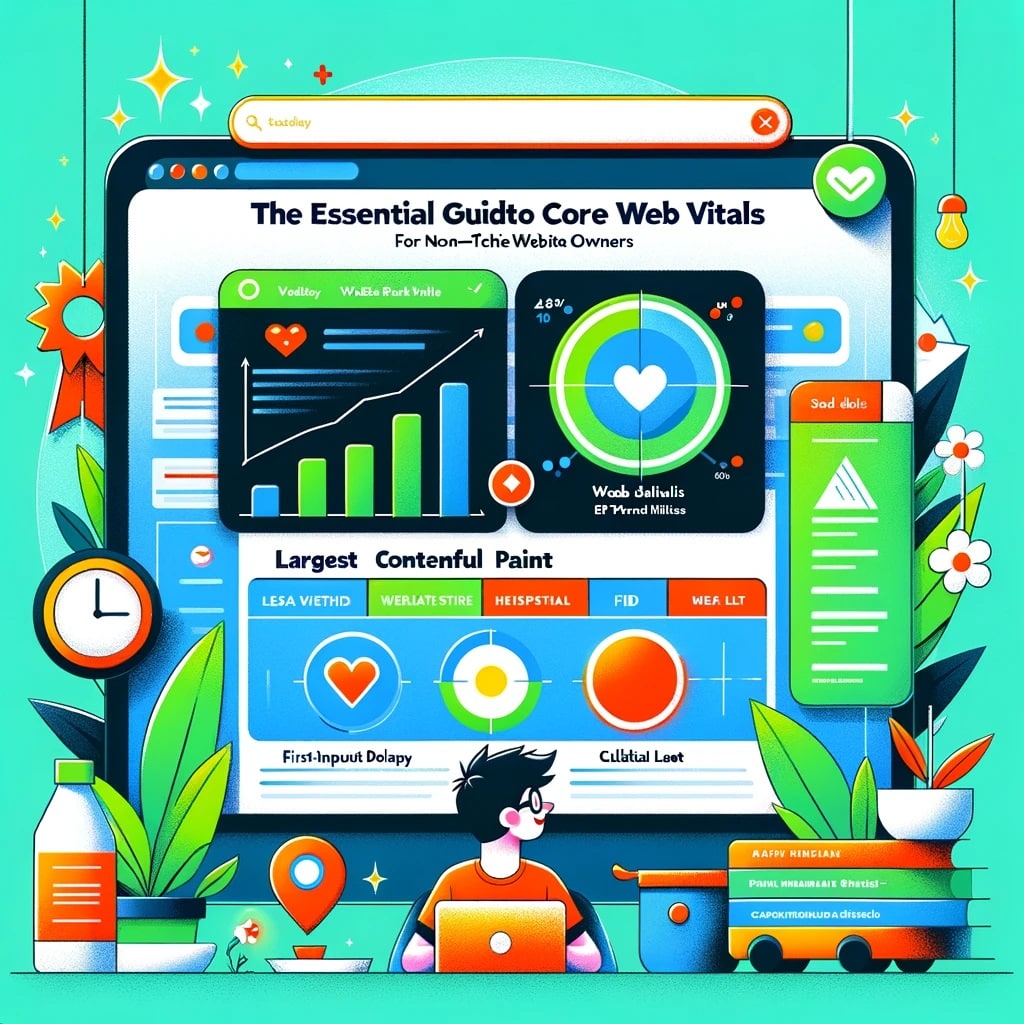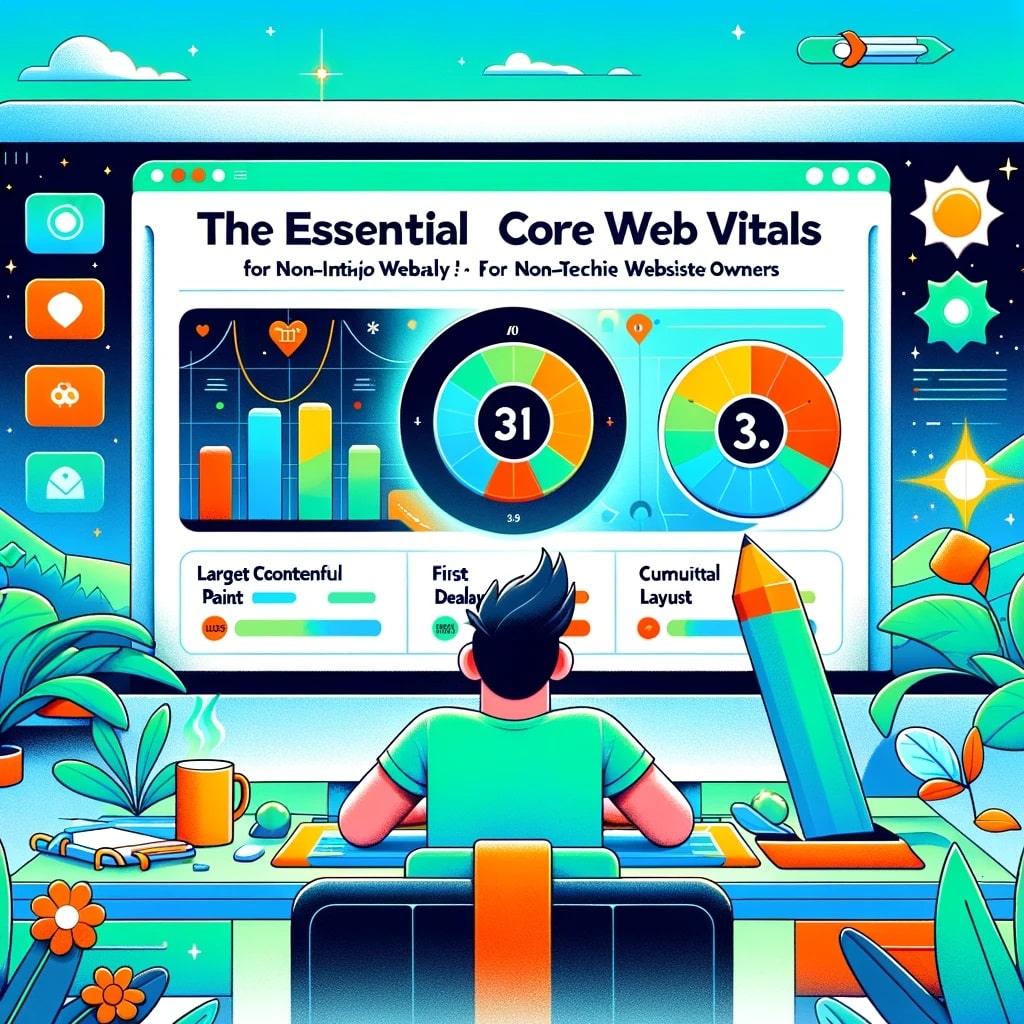Understanding Core Web Vitals
In the digital world, your website is more than simply a collection of pages; it serves as the digital front door to your company, providing many clients with their first impression of your brand. The same is true for your website, just as a friendly and comfortable store can make a significant difference in the customer experience. This is where Core Web Vitals come in, serving as a health check for your website’s user experience. Let’s go over the what, why, and how of Core Web Vitals in simple words that anyone can grasp.
What Are the Core Web Vitals?
Imagine entering into a business where the entrance door is clogged, the layout changes unexpectedly, and it takes awhile to receive help from anyone. Isn’t this frustrating? Core Web Vitals are Google’s method of assessing common issues that users may encounter on a website. They concentrate on three main aspects:
- Loading Performance (Largest Contentful Paint, or LCP): How quickly does your website’s main content load on the screen? Consider how quickly your store’s front door opens for customers.
- Interactivity (First Input Delay – FID, likely to be superseded by INP): How quickly can visitors interact with your website when it loads? This could include clicking a menu link or submitting their information onto a form. It’s similar to how quickly a staff member greets and services you in a store.
- Visual Stability (Cumulative Layout Shift – CLS): Do the items on your page move around as they load? This statistic ensures that nothing moves while your page loads, avoiding people from hitting the wrong button. Consider a store where the aisles and merchandise rearrange themselves as you shop; hardly ideal, right?
Why should you care?
Google values sites that provide a positive user experience and incorporates these data into their search ranking algorithms. A higher rank indicates increased visibility, which leads to more visits, possible leads, and consumers. Furthermore, a site that loads swiftly, responds rapidly, and does not move beneath your fingertips is simply more enjoyable to use, keeping your customers satisfied and more inclined to return.
How Can You Measure and Improve These Metrics?
Measuring Core Web Vitals:
Google provides tools and data, such as PageSpeed Insights and Search Console, to assist you analyze your website’s performance in various areas. You don’t have to be a technology expert to use them; they provide straightforward information and even suggestions for development.
Improving the Core Web Vitals:
Once you’ve assessed your site’s performance, you may discover areas that want improvement. Here’s how to address them in plain English:
- For Slow Loading (LCP): Optimize your photos and videos to make them load faster, and remove any superfluous fancy effects that slow down your website.
- For Poor Interactivity (FID/INP): Reduce the amount of JavaScript that runs when a page loads; this is similar to decreasing clutter in your business, allowing customers to move about more easily and swiftly.
- For Shifting information (CLS): Make sure pictures and advertising have a specified size so that as they load, they do not push other information around.
Who Should Manage Core Web Vitals?
Ideally, someone with some technical knowledge should handle the optimization, such as your web developer or an SEO specialist. However, as a website owner, you must comprehend these concepts even if you are not doing the work. It allows you to create appropriate goals for your team and ensure that your website provides the greatest possible experience.
In recent years, Google has prioritized the user experience (UX) as a key component in deciding search ranks. Core Web Vitals are at the center of this transition, as they provide actual, quantitative indicators of a website’s UX quality. Let’s look at how these parameters influence SEO strategies and their effects on Google rankings.

The Direct Impact on SEO
Core Web Vitals are expressly incorporated into Google’s algorithms as part of the Page Experience Update. This integration sends a clear message: websites that provide a better user experience, as measured by these metrics, are more likely to appear higher in search results. Largest Contentful Paint (LCP), First Input Delay (FID), and Cumulative Layout Shift (CLS) are measures that measure loading times, interactivity, and visual stability, respectively. By optimizing these areas, websites can have a direct impact on their SEO performance.
A shift in SEO strategies
Because of Google’s emphasis on Core Web Vitals, SEO strategies are developing. Traditional strategies based exclusively on keywords, backlinks, and content relevancy are no longer effective. To fulfill Core Web Vitals criteria, current SEO strategies must take a comprehensive strategy that includes technical optimization. This includes prioritizing website speed improvements, guaranteeing responsive interactive components, and maintaining layout consistency throughout the user’s experience on the site.
Do Core Web Vitals Help with Google Rankings?
Yes, there is a growing amount of information and case studies showing that increases in Core Web Vitals correlate with higher search ranks. Websites that have concentrated on optimizing these indicators frequently claim improvements in both search rankings and user engagement metrics such as bounce rate and conversion rate. This development is due to Google’s algorithms increasingly rewarding websites that provide a fast, seamless, and interesting user experience.
The Future of SEO and Core Web Vitals
Looking ahead, it is evident that Core Web Vitals will continue to play an important role in SEO and Google rankings. Google has said that the metrics for Core Web Vitals will change based on user experience requirements. This means that website owners and SEO professionals must stay current on these changes and constantly monitor and enhance their sites’ performance in these areas.
Furthermore, as Google improves its ability to measure user experience, we may expect to see other user-centric measures added and incorporated into search ranking algorithms. This progression highlights the significance of taking a user-first approach to SEO, which includes optimizing for Core Web Vitals.
Core Web Vitals: Advanced Strategies
Improving your website’s Core Web Vitals is a continual effort that needs meticulous attention to detail and a proactive mindset. While the fundamentals will get you started, digging deeper into optimization tactics can greatly improve your site’s user experience and performance. Here are additional sophisticated recommendations and concrete guidance for website owners who want to manage their Core Web Vitals:
Dive further into optimization
- Prioritize Mobile Experience: With the majority of internet users accessing the web through mobile devices, optimizing for mobile is no longer an option. Mobile customers demand speedy and responsive interactions, therefore work on enhancing your mobile site’s Core Web Vitals. Test your website on a variety of devices and connection speeds to ensure a consistent and seamless experience.
- Use Browser Caching: Browser caching saves specific elements of your site on users’ devices so they don’t have to be downloaded again during subsequent visits. This can significantly boost LCP for return visitors. Work with your web developer to enable caching for static resources such as photos, CSS files, and JavaScript.
- Reduce Third-Party Scripts: External scripts for analytics, marketing tools, and other services can have a major impact on your website’s performance. Check your website for unneeded scripts and remove or replace them with more effective alternatives. Consider lazy loading critical scripts, which implies loading them only when needed.
- Adopt Next-Gen Image Formats: Images make up a big amount of web content, and optimizing them can result in considerable improvements in LCP. Use new, compressed image formats such as WebP, which have better compression and quality features than traditional formats such as JPEG or PNG. This decreases the size of photographs without sacrificing quality.
- Implement Critical CSS: CSS is used to style web pages, however not all styles are required immediately when the page loads. Identify and include essential CSS (the minimum set of styles required to render above-the-fold content) directly in your HTML. This ensures that the content loads rapidly, boosting LCP, while the remaining CSS may be loaded asynchronously.
Engage professionals when necessary
While some optimizations are simple, others may necessitate a greater understanding of web technologies. Don’t be afraid to seek professional assistance with complex issues, particularly those involving server configuration, advanced coding, or a thorough investigation of your site’s performance bottlenecks. A seasoned web developer or an SEO consultant with a technical background might be really helpful.
Monitor and adjust regularly
Core Web Vitals and web technology develop, so what works today may not be successful tomorrow. Regular monitoring and modifications are essential for maintaining and increasing your website’s performance. Monitor your Core Web Vitals scores using Google’s Search Console and other analytics tools, and be ready to adjust your methods as needed.
Educate your team
If you work in a team, ensure that everyone knows the significance of Core Web Vitals and how their contributions affect these metrics. From designers selecting picture formats to developers writing fast code, every team member contributes to improving the user experience.
Optimizing for Core Web Vitals is more than just checking boxes to please search engines; it is about committing to giving the greatest possible experience for your visitors. By taking a precise, knowledgeable approach to optimization and being up to date on the latest changes, you can ensure that your site not only ranks well but also delights visitors, enticing them to return again and again. Remember that in the digital age, user experience reigns supreme, and Core Web Vitals are your guide to achieving it.

Summary – Core Web Vitals: A Comprehensive Overview
Understanding Core Web Vitals
- Core Web Vitals are Google’s assessment of common issues on a website.
- They focus on three main aspects: Loading Performance (Largest Contentful Paint, or LCP), Interactivity (First Input Delay – FID, likely to be superseded by INP), and Visual Stability (Cumulative Layout Shift – CLS).
Why Should You Care?
- Google values sites that provide a positive user experience and incorporates these data into their search ranking algorithms.
- A higher rank indicates increased visibility, leading to more visits, possible leads, and consumers.
- A site that loads swiftly, responds rapidly, and does not move beneath your fingertips is more enjoyable to use, keeping customers satisfied and more inclined to return.
Measuring and Improving Core Web Vitals
- Google provides tools and data such as PageSpeed Insights and Search Console to help analyze your website’s performance.
- Improvements can be made to areas that need improvement.
- For Slow Loading (LCP), optimize photos and videos to make them load faster.
- For Poor Interactivity (FID/INP), reduce the amount of JavaScript that runs when a page loads.
- For Shifting information (CLS), ensure pictures and advertising have a specified size so that they do not push other information around.
Who Should Manage Core Web Vitals?
Ideally, someone with some technical knowledge should handle the optimization, such as your web developer or an SEO specialist. As a website owner, understanding these concepts allows you to create appropriate goals for your team and ensure that your website provides the greatest possible experience.
Google’s Prioritization of User Experience in Search Rankings
- Google’s Page Experience Update incorporates Core Web Vitals as a key indicator of a website’s UX quality.
- Websites with better UX metrics, such as Largest Contentful Paint (LCP), First Input Delay (FID), and Cumulative Layout Shift (CLS), are more likely to appear higher in search results.
- SEO strategies are evolving to include technical optimization, including website speed improvements, responsive interactive components, and maintaining layout consistency.
- Increases in Core Web Vitals correlate with higher search ranks, improving user engagement metrics like bounce rate and conversion rate.
- The future of SEO and Core Web Vitals is uncertain, with Google predicting changes in Core Web Vitals metrics based on user experience requirements.
- As Google improves its ability to measure user experience, other user-centric measures may be added to search ranking algorithms.
About the Author:
With over 14 years of seasoned expertise in Technical SEO consulting, Eugen Platon SEO Expert stands at the forefront of the evolving digital marketing landscape. His approach to Technical SEO (search engine optimization) is both comprehensive and bespoke, ensuring that each technical SEO project he undertakes is finely tuned to its unique requirements and goals. He excels in elevating website visibility, bolstering user engagement, and navigating the ever-changing currents of SEO. Under his guidance, your online presence is transformed into a dynamic digital force, adeptly meeting and surpassing set objectives. Eugen combines time-tested SEO strategies with cutting-edge AI powered SEO techniques, dedicating himself to transforming your digital footprint into a magnet for both search engines and your target audience. Embark on a journey with him to unlock the full SEO potential of your online presence.


